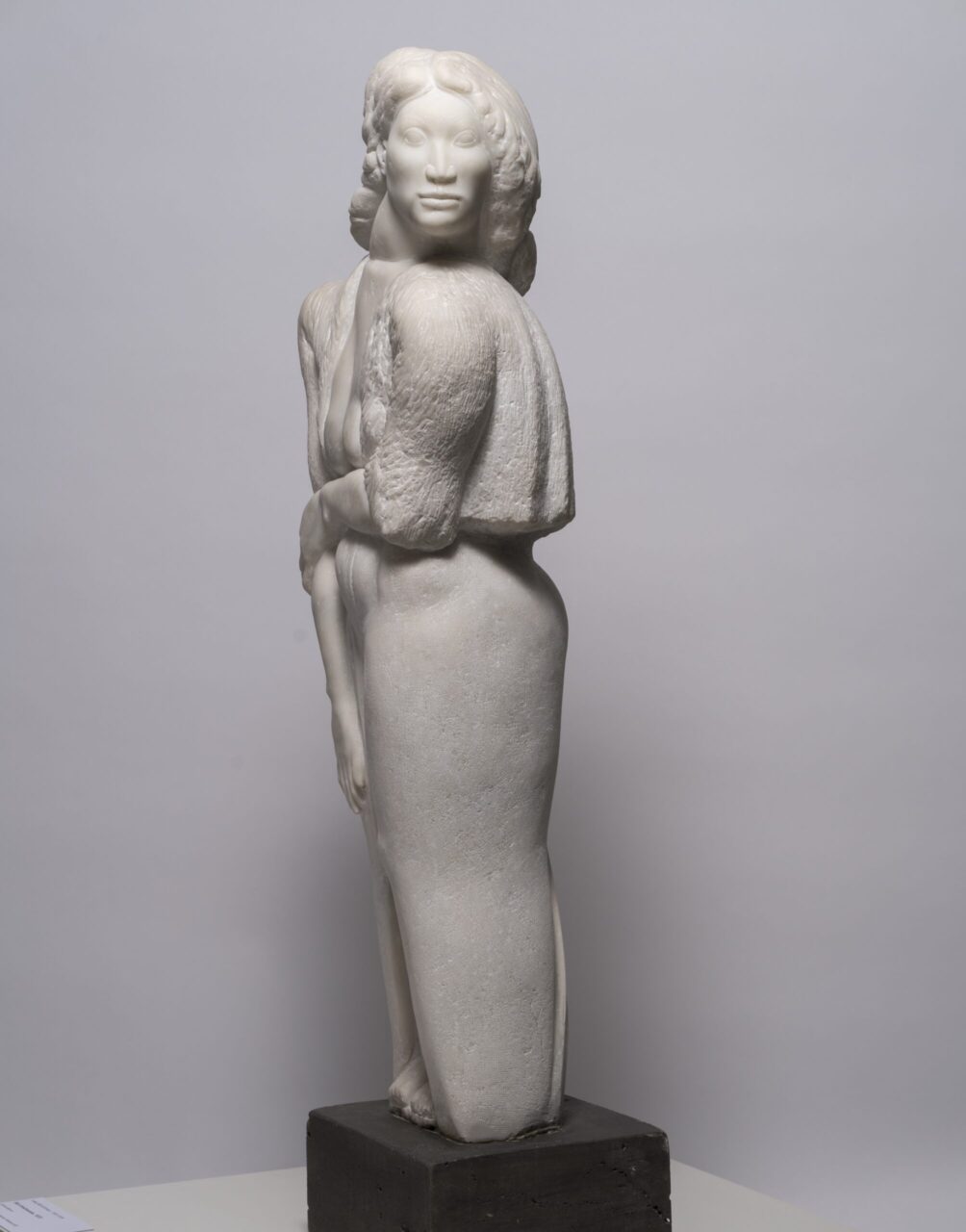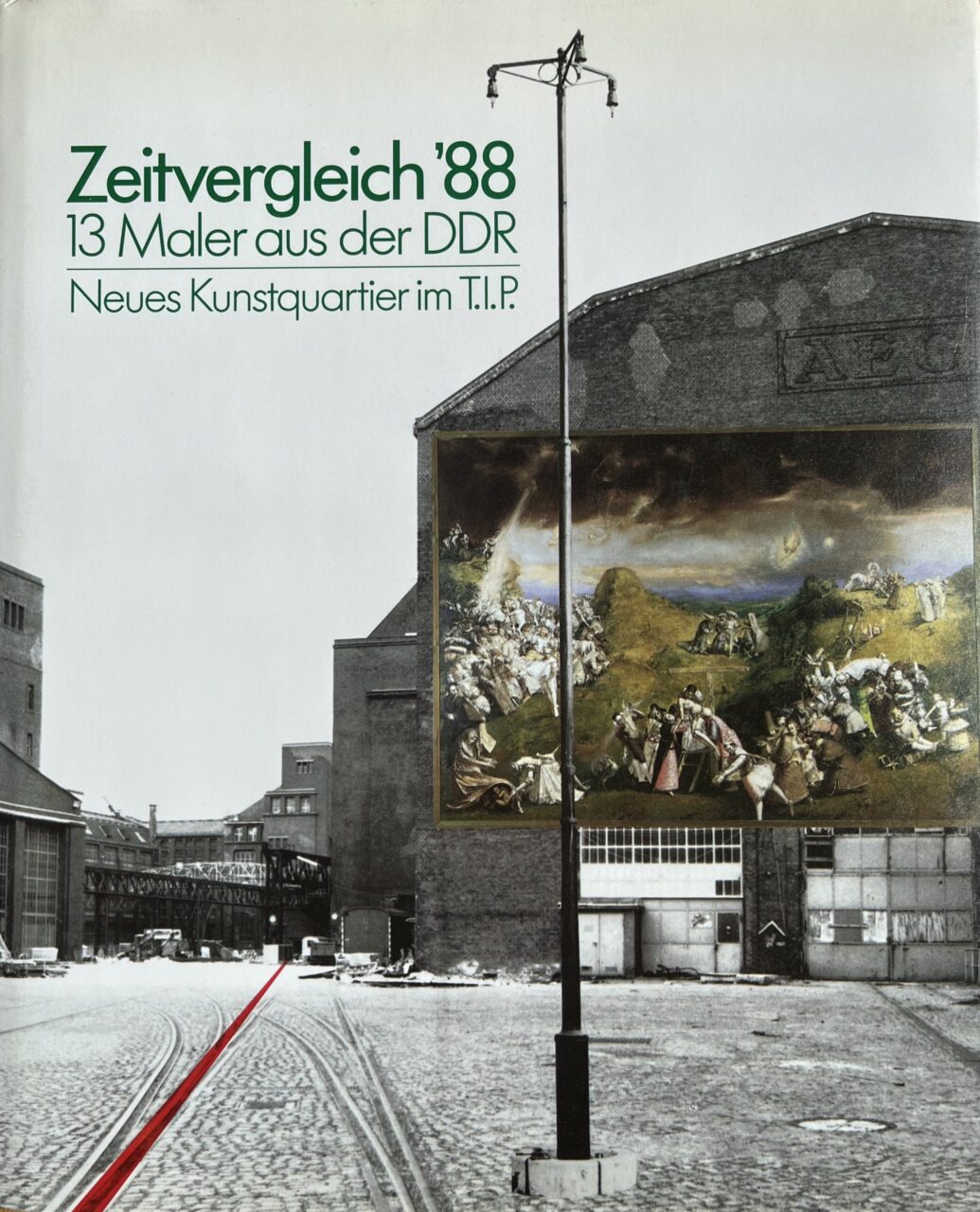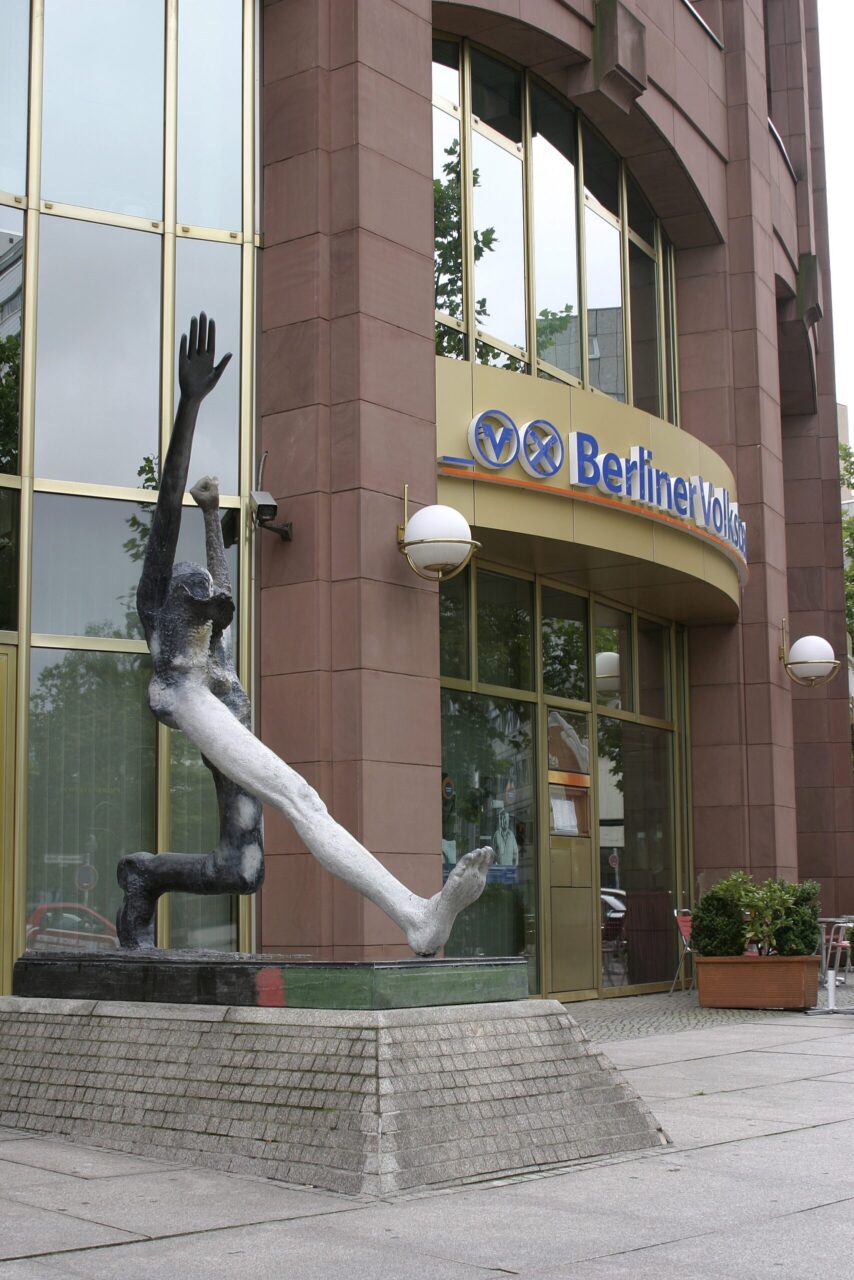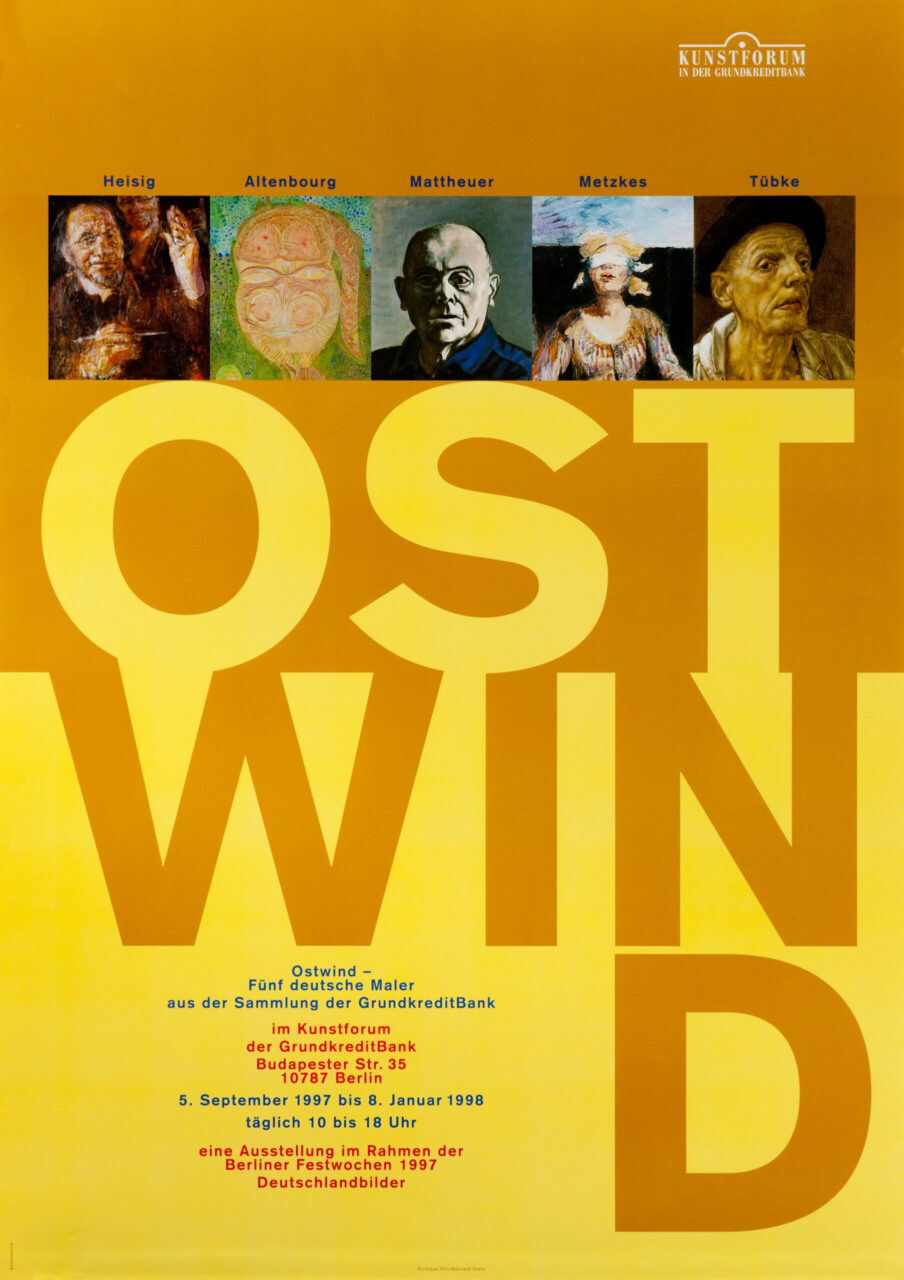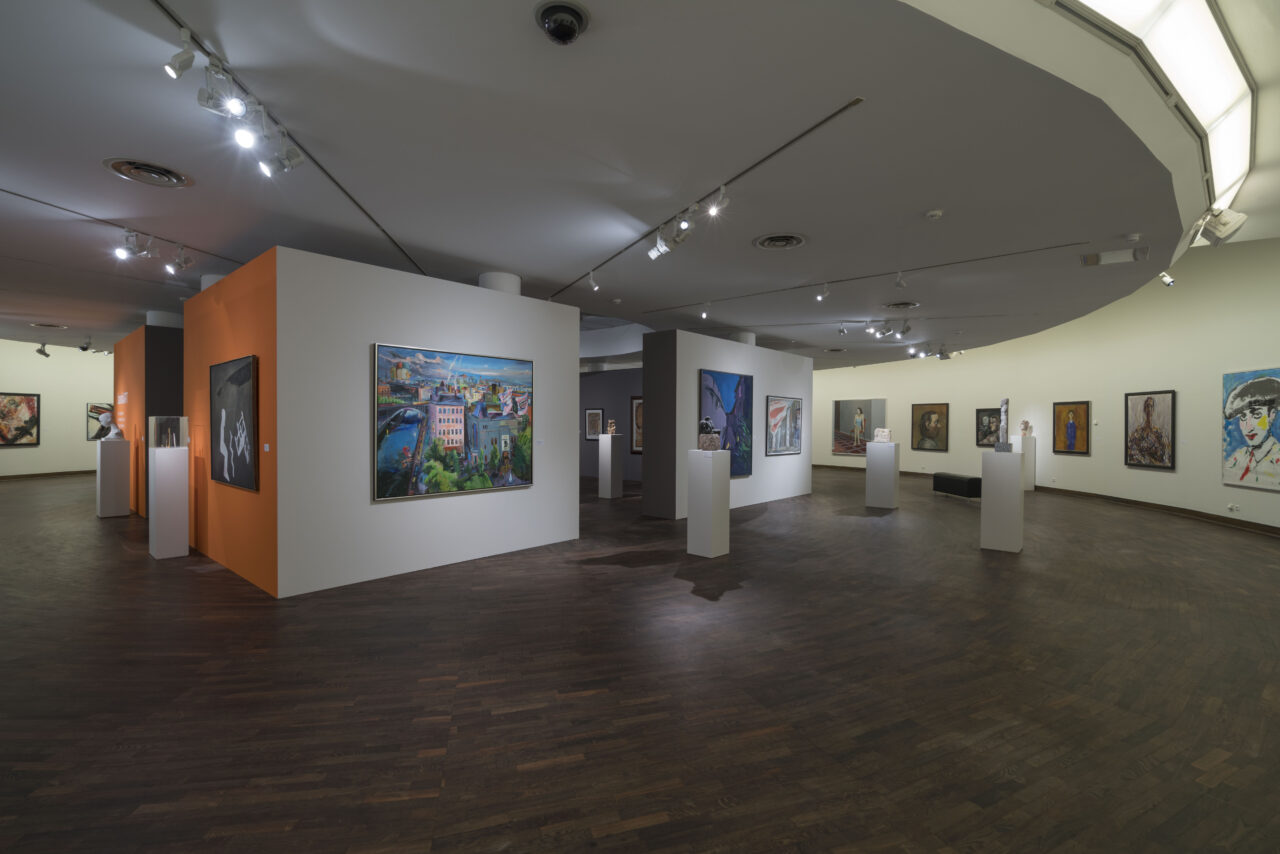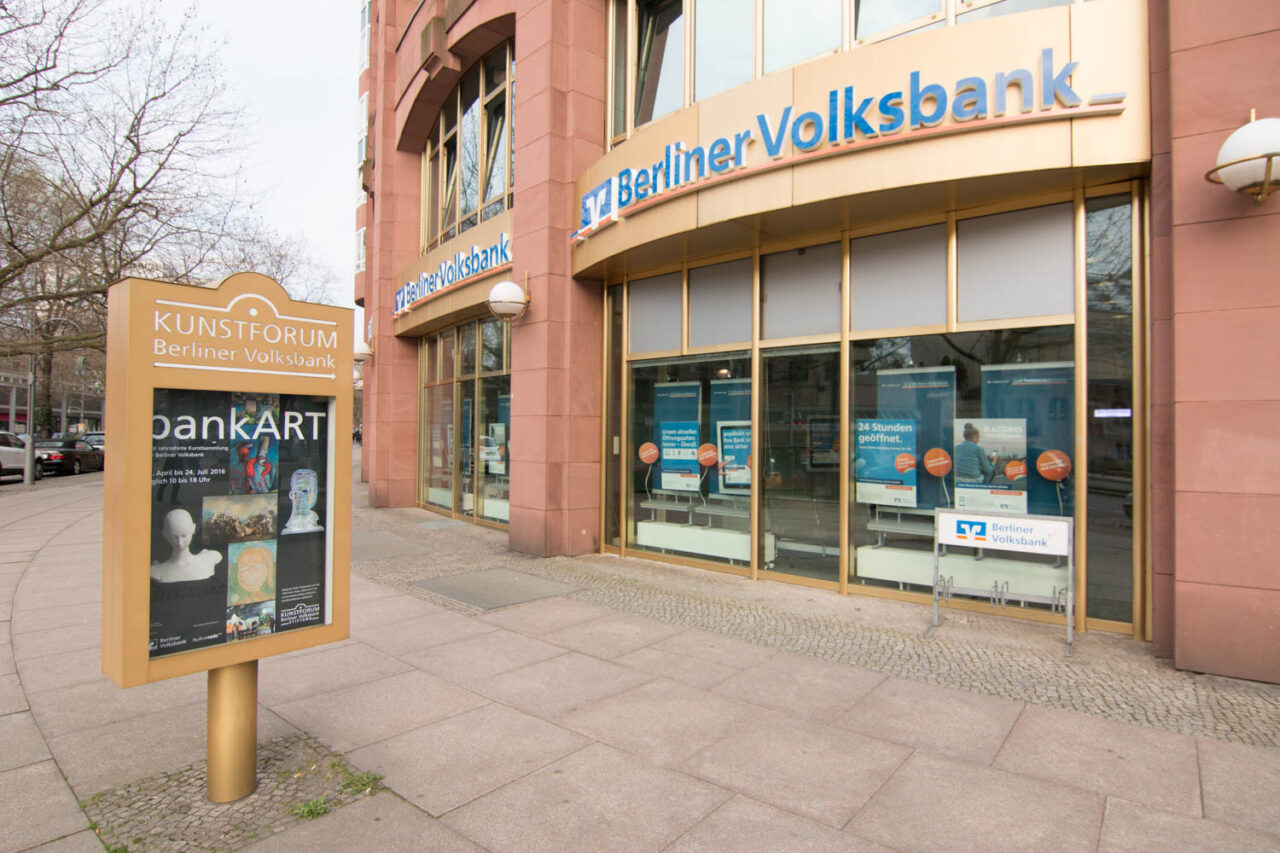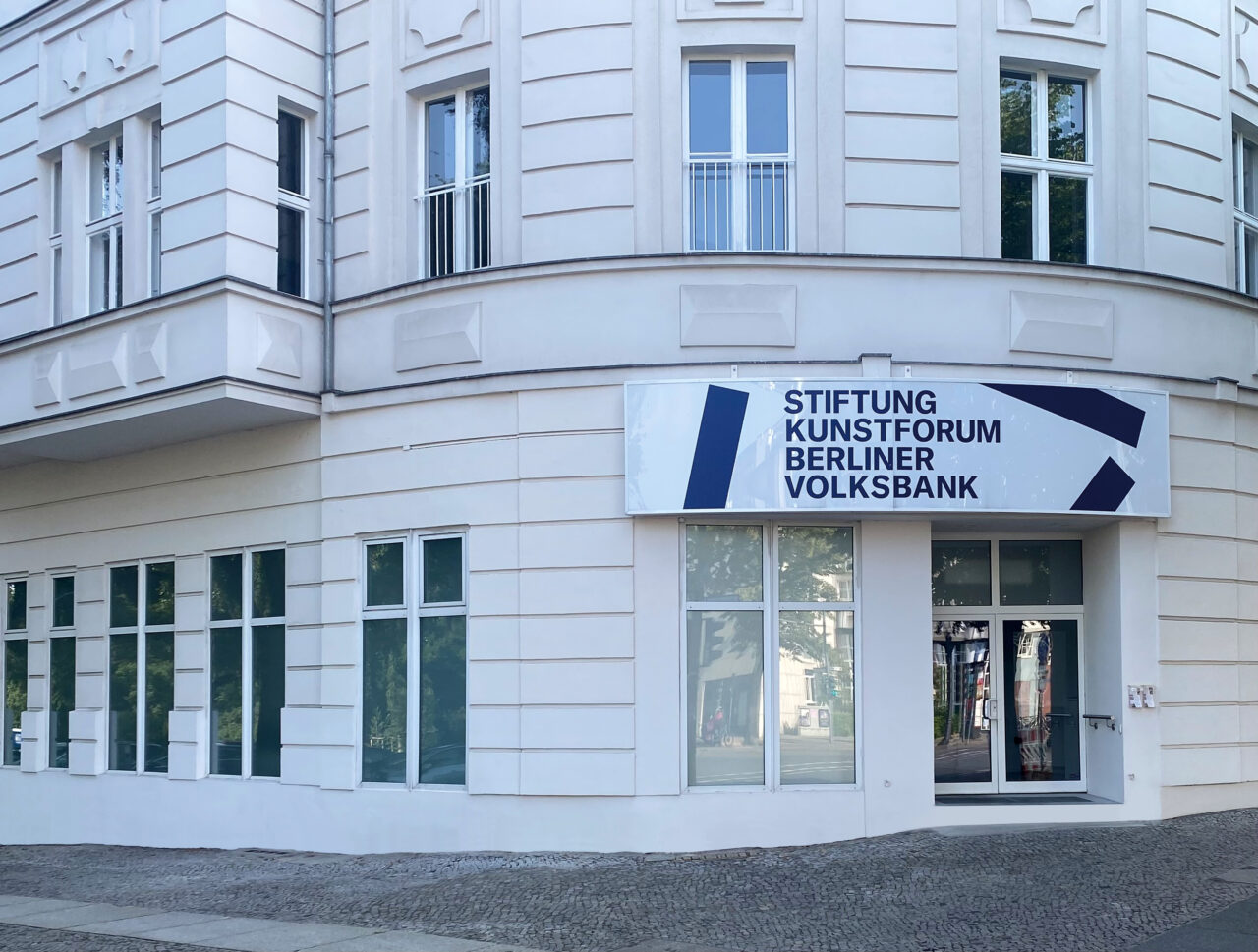How did a West Berlin bank come to collect art from the GDR in the 1980s? A time-travel journey in pictures retraces the beginnings of the Berliner Volksbank’s collection, telling a story of bold choices, pioneering exhibitions, and the dismantling of cultural barriers in a divided city.
1985—1987
In 1985 the then GrundkreditBank opened its new headquarters on Budapester Straße in Charlottenburg. Its chairman, Jürgen Bostelmann (1940—2014), an avid art lover, established an exhibition hall—the ›Kunstforum‹—on the ground floor and began acquiring artworks, strengthening the bank’s cultural commitment to the city. Those decisions laid the foundation for today’s Stiftung Kunstforum Berliner Volksbank.
In early 1986, the GrundkreditBank acquired its first artwork: the marble sculpture ›Sich Umschauende‹ by Ludwig Gabriel Schrieber.
In 1987 the well-known art dealer Dieter Brusberg (1935—2015), active on both sides of the Wall, was commissioned to develop a collection concept. His proposal: a focus on regional figurative art under the motto ›Images of People—Images for People‹. Placing the human being at the centre, his vision reflected the bank’s cooperative philosophy.
What stands out is the deliberate choice to acquire art from the GDR—a visionary step for a West German institution. A key figure in enabling and securing these acquisitions was Rüdiger Küttner, then director of the Staatlicher Kunsthandel, East Germany’s state-controlled art trade.
Works by artists such as Harald Metzkes (Berlin School), Werner Tübke, and Wolfgang Mattheuer (Leipzig School) formed the foundation of the collection. From the outset, particular emphasis fell on the Thuringian artist Gerhard Altenbourg—one of the most independent voices to emerge from the GDR.
1988—1989
In 1988 the painting exhibition ›Zeitvergleich ’88—13 Maler aus der DDR‹ was staged on behalf of the Berliner Festspiele. Organised and curated by Dieter Brusberg together with the Staatlicher Kunsthandel, it marked the first time the East German institution directly took part in presenting contemporary GDR art in West Berlin.
The media response was immense: Dietmar Keller, Deputy Minister of Culture of the GDR, and West Berlin’s Governing Mayor Eberhard Diepgen attended the opening side by side. It marked the very first official appearance by a member of the GDR government in West Berlin.
From this exhibition the GrundkreditBank acquired twenty-seven works, including pieces by Harald Metzkes, Wolfgang Peuker, Walter Libuda, and Angela Hampel—the only female artist represented in the show.
1990 – 1993
At Wolfgang Mattheuer’s request, the GDR’s Ministry of Culture granted permission in 1990 to sell an iron cast of his sculpture ›Jahrhundertschritt‹ to GrundkreditBank. Installed in front of the bank building on 27 August 1990, the work had first been shown in 1985 at the 11th Art Exhibition of the Leipzig District and again in 1987 at the 10th Art Exhibition of the GDR in Dresden. ›Jahrhundertschritt‹ became a striking symbol of the ambivalence of historical progress and drew widespread attention in the GDR.
In 1991 GrundkreditBank presented its art collection to the public for the first time in a major exhibition at the Kunstforum. ›Staatskünstler—Harlekin—Kritiker? DDR-Malerei als Zeitdokument‹ brought together works by Gerhard Altenbourg, Bernhard Heisig, Werner Tübke, and many others. The aim was to spark dialogue: what paths did artists’ careers take within the structures of GDR cultural policy? And what can painting reveal about the social climate of the GDR that official records leave unsaid?
In 1992 and 1993 GrundkreditBank expanded its collection, acquiring, among other works, Werner Tübke’s large-scale painting ›Ende der Narrengerichtsbarkeit IV‹. It also purchased four works by Horst Antes, an early West German representative of the ›New Figuration‹ of the 1960s.
1997—2004
With ›Ostwind. Fünf deutsche Maler aus der Sammlung der GrundkreditBank‹, the Kunstforum staged an exhibition in 1997 as part of the Berliner Festwochen. Echoing the festival’s theme ›Deutschlandbilder‹ (pictures of Germany), Dieter Brusberg presented key works from the collection by Gerhard Altenbourg, Bernhard Heisig, Wolfgang Mattheuer, Harald Metzkes, and Werner Tübke.
In 1998/1999, GrundkreditBank merged with Berliner Volksbank under the leadership of CEO Karl Kauermann, creating the largest cooperative bank in Germany. Kauermann, himself an avid art collector, used his conviction and influence to ensure that the GrundkreditBank’s art collection survived the restructuring process. The holdings expanded with the Berliner Volksbank’s collection and the new focus on ›Berliner Stadtbilder‹ (Berlin cityscapes). Artists such as Kerstin Baudis, Helge Leiberg, Markus Lüpertz, and Ulla Walter were added to the collection.
In 1999, Bärbel Mann, then head of the collection, curated ›Dialoge. Werke aus der Sammlung der GrundkreditBank‹. This was the first exhibition to include all the artists in the collection without placing special emphasis on those from East Germany.
2005—2016
For the twentieth anniversary of the collection, the exhibition ›Bilder & Bilanzen. Von Antes bis Zylla‹ traced the development of figurative art in Berlin and Brandenburg. The show played a key role in placing art from the GDR within an art-historical context and emphasising its significance—while also including artists from the West.
Works by the ›Neue Wilde‹ and the artist-run gallery Großgörschen 35, along with other West German positions, were added to the collection. These included groups of works by Rainer Fetting, Klaus Fußmann, K. H. Hödicke, and Max Kaminski. The collection was now known as the ›Kunstsammlung der Berliner Volksbank‹ and comprised one thousand works by around one hundred artists, with East and West German art brought into balance.
2005 saw the launch of the ›Werkstatt für Kreative‹—a creative workshop that constituted one of the first art education programmes for children and teenagers in Berlin and Brandenburg.Berliner Volksbank established the independent, non-profit Stiftung KUNSTFORUM der Berliner Volksbank gGmbH in 2007. Since then, the foundation has overseen the care and expansion of the collection, its exhibitions, and the ›Werkstatt für Kreative‹.
New works were added, including those by Konrad Knebel, Ursula Strozynski, and Manfred Butzmann. Pieces by sculptors such as Wieland Förster, Sabina Grzimek, Ingeborg Hunzinger, Fritz Cremer, and Berndt Wilde also became part of the collection.
2016—2020
In 2016 ›bankART. Drei Jahrzehnte Kunstsammlung der Berliner Volksbank‹ presented three decades of work from the collection. The show also marked the final exhibition at the bank’s headquarters on Budapester Straße.
In 2018 the Kunstforum moved to its new home at Kaiserdamm 105 in Charlottenburg. Since its opening that November, it has staged two exhibitions each year, designed to reflect the breadth and diversity of the Berliner Volksbank collection.
The collection has since expanded to include artists from the GDR’s alternative scene, among them Annemirl Bauer, Sabine Herrmann, Uta Hünniger, Klaus Killisch, and Cornelia Schleime.
The transfer of the collection to the Stiftung KUNSTFORUM der Berliner Volksbank gGmbH—initiated by former chairman of the board Holger Hatje—was formally completed in 2019 by the current chairman, Carsten Jung. This move safeguarded the collection against resale and ensured its long-term protection.
In 2019, Sebastian Pflum took over as the new managing director and director of the Kunstforum.
2021—2025
In 2021 the venue adopted a new name: ›Stiftung Kunstforum Berliner Volksbank‹. Marking the 35th anniversary of the Berliner Volksbank art collection, the exhibition ›WIR. Nähe und Distanz‹ opened—curated not by professionals but by the bank’s own employees, who selected around sixty works by forty-five artists from the collection.
In February 2022 the exhibition ›CASH on the Wall‹ explored how artists have engaged with the theme of money in recent decades. That autumn Stiftung Kunstforum Berliner Volksbank joined forces with Stiftung Stadtmuseum Berlin for ›Aufbrüche. Abbrüche. Umbrüche. Kunst in OstBerlin 1985—1995‹, bringing their collections together to spotlight East Berlin’s art scene at a pivotal historical moment.
In November 2024, marking the 35th anniversary of the fall of the Berlin Wall and the peaceful revolution, the Stiftung presented ›Die Mauer: vorher, nachher, Ost & West‹ at the Max Liebermann Haus on Pariser Platz. Organised together with Stiftung Brandenburger Tor, the show focused almost entirely on works from the Berliner Volksbank art collection.
In 2025 the Berliner Volksbank art collection celebrates its 40th anniversary with the exhibition ›MENSCH BERLIN‹, which will also travel to Kunstforum Wien. During Berlin Art Week 2025, it stages ›Paradies‹, curated by contemporary artist Christian Thoelke. Today the collection comprises more than 1,500 works by around 200 artists.
